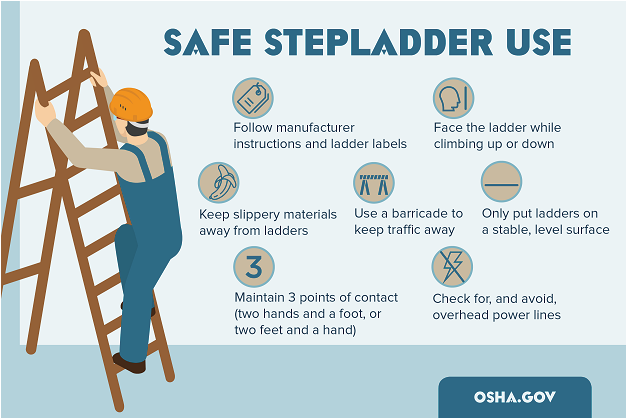
One of the most common workplace accidents involves ladder-related injuries. In the United States, over 500,000 people experience ladder-related injuries each year at work or home, and more than 300 people die from such injuries.
In retail, a fall typically involves an employee who’s using a portable ladder, such as step and extension ladders, as they rush to help a customer.
“Taking time, not rushing, and watching one’s step is critical to preventing falls from ladders,” says the Centers for Disease Control and Prevention. “Falls can cause back injuries, sprains, strains, contusions, fractures, severe head injuries, paralysis, and even death.”
Here are common things to look out for:
SETTING UP THE LADDER
- When using portable ladders, inspect the ladder to be sure that all rungs or steps are in place and secure. Second, inspect the floor surface where each foot or rail contacts the floor. This surface needs to be level, dry, and clean.
- For a free-standing portable ladder, such as a step ladder, make sure it is fully open, the spreaders are correctly secured, and all four feet are in contact with the floor.
- For ladders that aren’t free-standing, position it against a nearby vertical surface, railing, or shelf that is secure. Don’t rest the top of the ladder against anything breakable or movable such as a window.
- Once the ladder is upright and resting against a surface, adjust it to the proper angle. Use the 4-to-1 placement rule: for every 4 feet of height you have to climb, move the base 1 foot away from the wall.
MISJUDGING THE LAST STEP
- Once a portable ladder is correctly positioned, a common fall incident occurs when the user is climbing down and misjudges the location of the last step.
- Users can mistakenly think that their foot is about to touch the floor, when in fact the floor is actually 24 inches from the second-to-last rung. To avoid falling, they must quickly realize —before shifting their weight to step down — that there is another rung on the ladder. Ladder users are reminded to be aware of this potential mis-stepping hazard and take precautions in their actions when climbing down a ladder.
TRANSPORTING ITEMS
- Typically when climbing down a ladder, workers are carrying a box or item retrieved from an upper shelf. With one hand holding the item and the other hand holding onto the ladder, their descent can be far from safe. Best practices suggest that three points of contact are needed at all times to safely ascend or descend a portable ladder, which is possible only if both hands are free for holding onto the ladder.
- One solution is for the worker to lower the item in a container or basket. A co-worker can help keep the ladder secure and take the item from the basket. If no co-worker is available to help, then the ladder-climber can put the item in a shoulder bag or back-pack. This prevents a visual obstruction and frees both hands for descending.
The CDC provides the free ladder safety app for a smart phone or tablet. Its “angle measuring tool” has both a visual indicator and an audible signal to help position a ladder at the safest angle for climbing. Go to bitly.com/safeladders.

